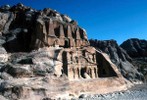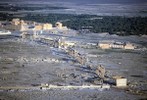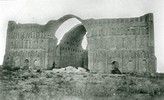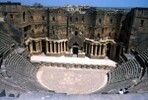Concepts
Islam: One of today's global religions and the third monotheistic religion, revealed after Judaism and Christianity and accepting them both. Brought by the Prophet Muhammad (570-632) in Arabia, it soon spread all over the southern and eastern Mediterranean, Africa, and south, east, and central Asia. In Arabic, the word Islam literally means "to surrender, to submit (to the will of God)", which is the essence of the religion.
Mecca: Birthplace of the Prophet Muhammad and a major trading center in Arabia that linked Byzantine Syria in the north with Yemen in the south. The tribe of Qureish lived in Mecca and was divided into 40 clans of varying wealth and status.
Qibla: The direction of Mecca toward which Muslims are required to face when they perform their prayer.
Mecca: The cult and trade center.
The Palaces of Yemen: Signs of a sophisticated agrarian culture.
Monuments
Petra: The Nabatean capital carved in the rock with hybrid Hellenistic sensitivities.
The Ka'ba in Mecca: The center of worship and pilgrimage before Islam which became the axis mundi of Islam's conception of the universe and the qibla towards which worshippers face when praying. Date of building unknown.
Palmyra: A caravan city turned imperial center with heavy Roman influences.
Mada`in Salih, Saudi Arabia: North Arabian, Nabatean trade cities that connected Syria in the North and Yemen in the South.
Iwan Kisra at Ctesiphon: The seat of Sassanian kings, the rulers of the second superpower of the time (other than Byzantium).
Rusafa (Sergiopolis): Capital of the Ghassanids, clients of Constantinople.
Bostra (Bosra): A Syrian-Roman city and another capital of the Ghassanids; the illustration of urban splendor in the eyes of the Prophet Muhammad.





